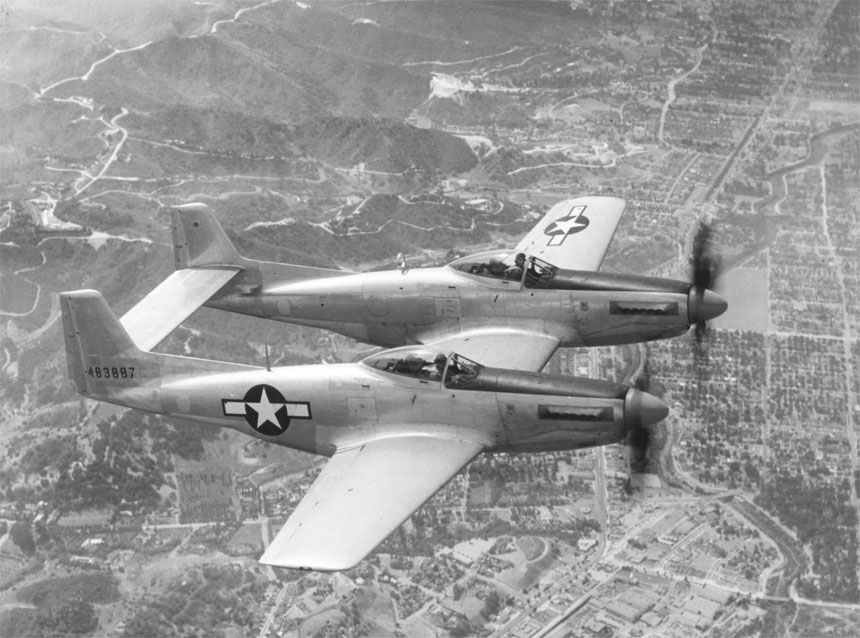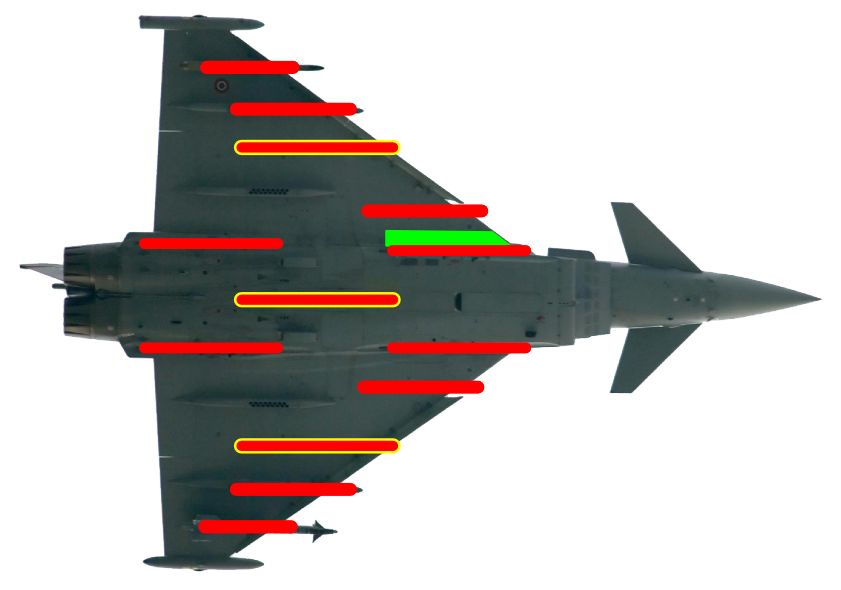|
F-82E Twin Mustang
The North American F-82 Twin Mustang is an American long-range escort fighter. Based on the North American P-51 Mustang, the F-82 was designed as an escort for the Boeing B-29 Superfortress in World War II, but the war ended well before the first production units were operational. The F-82 was the last American piston-engined fighter ordered into production by the United States Air Force. In the postwar era, Strategic Air Command used the aircraft as a long-range escort fighter. Radar-equipped F-82s were used extensively by the Air Defense Command as replacements for the Northrop P-61 Black Widow as all-weather day/night interceptors. During the Korean War, Japan-based F-82s were among the first USAF aircraft to operate over Korea. The first three North Korean aircraft destroyed by U.S. forces were shot down by F-82s, the first being a North Korean Yak-11 downed over Gimpo Airfield by the USAF 68th Fighter Squadron. Design and development Initially intended as a very lon ... [...More Info...] [...Related Items...] OR: [Wikipedia] [Google] [Baidu] |
Escort Fighter
The escort fighter was a concept for a fighter aircraft designed to escort bombers to and from their targets. An escort fighter needed range long enough to reach the target, loiter over it for the duration of the raid to defend the bombers, and return. A number of twin-engined heavy fighters with high fuel capacity were designed for escort duties prior to the outbreak of World War II. Such heavy fighters largely failed in their intended escort role during the war, as they were commonly outmaneuvered by more agile single-engined fighters. As the war progressed, longer-range fighter designs and the use of drop tanks allowed single-engined fighters to perform escort duties. In the post-war era the introduction of jet engines and their inherent short range made escort fighters very difficult to build. The related concept of a penetration fighter emerged briefly in the 1950s and again in the 1960s, but did not result in any production aircraft. Parasite fighters—small aircraf ... [...More Info...] [...Related Items...] OR: [Wikipedia] [Google] [Baidu] |
Operation Downfall
Operation Downfall was the proposed Allied plan for the invasion of the Japanese home islands near the end of World War II. The planned operation was canceled when Japan surrendered following the atomic bombings of Hiroshima and Nagasaki, the Soviet declaration of war, and the invasion of Manchuria. The operation had two parts: Operation Olympic and Operation Coronet. Set to begin in November 1945, Operation Olympic was intended to capture the southern third of the southernmost main Japanese island, Kyūshū, with the recently captured island of Okinawa to be used as a staging area. In early 1946 would come Operation Coronet, the planned invasion of the Kantō Plain, near Tokyo, on the main Japanese island of Honshu. Airbases on Kyūshū captured in Operation Olympic would allow land-based air support for Operation Coronet. If Downfall had taken place, it would have been the largest amphibious operation in history, surpassing D-Day. Japan's geography made this inva ... [...More Info...] [...Related Items...] OR: [Wikipedia] [Google] [Baidu] |
Allison V-1710
The Allison V-1710 aircraft engine designed and produced by the Allison Engine Company was the most common United States, US-developed V12 engine, V-12 Internal combustion engine cooling, liquid-cooled engine in service during World War II. Versions with a turbocharger gave excellent performance at high altitude in the twin-engined Lockheed P-38 Lightning, and turbo-superchargers were fitted to experimental single-engined fighters with similar results. The United States Army Air Corps (USAAC) preference for turbochargers early in the V-1710's development program meant that less effort was spent on developing suitable mechanically driven centrifugal superchargers for the Allison V-12 design, as other V-12 designs from friendly nations like the British Rolls-Royce Merlin were already using. When smaller-dimensioned or lower-cost versions of the V-1710 were desired, they generally had poor performance at higher altitudes. Design and development The Allison Engine Company, Allis ... [...More Info...] [...Related Items...] OR: [Wikipedia] [Google] [Baidu] |
Packard
Packard (formerly the Packard Motor Car Company) was an American luxury automobile company located in Detroit, Michigan. The first Packard automobiles were produced in 1899, and the last Packards were built in South Bend, Indiana, in 1958. One of the "Three Ps" – alongside Peerless Motor Company and Pierce-Arrow – the company was known for building high-quality luxury automobiles before World War II. Owning a Packard was considered prestigious, and surviving examples are often found in museums and automobile collections. Packard vehicles featured innovations, including the modern steering wheel, air-conditioning in a passenger car, and one of the first production 12-cylinder engines, adapted from developing the Liberty L-12 engine used during World War I to power warplanes. During World War II, Packard produced 55,523 units of the two-stage/two-speed supercharger equipped Merlin V-12s engines under contract with Rolls-Royce. Packard also made the versions of the Li ... [...More Info...] [...Related Items...] OR: [Wikipedia] [Google] [Baidu] |
Rolls-Royce Merlin
The Rolls-Royce Merlin is a British Coolant#Liquids, liquid-cooled V12 engine, V-12 Reciprocating engine, piston aero engine of 27-litre (1,650 cu in) Engine displacement, capacity. Rolls-Royce Limited, Rolls-Royce designed the engine and first ran it in 1933 as a private venture. Initially known as the PV-12, it was later called ''Merlin (bird), Merlin'' following the company convention of naming its four-stroke piston aero engines after birds of prey. The engine benefitted from the racing experiences of precursor engines in the 1930s. After several modifications, the first production variants of the PV-12 were completed in 1936. The first operational aircraft to enter service using the Merlin were the Fairey Battle, Hawker Hurricane and Supermarine Spitfire. The Merlin remains most closely associated with the Spitfire and Hurricane, although the majority of the production run was for the four-engined Avro Lancaster heavy bomber. The Merlin continued to benefit from a s ... [...More Info...] [...Related Items...] OR: [Wikipedia] [Google] [Baidu] |
Packard V-1650 Merlin
The Packard V-1650 Merlin is a version of the Rolls-Royce Merlin aircraft engine, produced under license in the United States by the Packard Motor Car Company.Gunston 1995, p. 144. The engine was licensed to expand production of the Rolls-Royce Merlin for British use. The engine also filled a gap in the U.S. at a time when similarly powered American-made engines were not available. The first V-1650s, with a one-stage supercharger, equivalent to the Merlin XX, were used in the P-40F Kittyhawk fighter and in Canadian-built Hawker Hurricanes. Later versions based on the Merlin 60 series included a more advanced two-stage supercharger for improved performance at high altitudes. It found its most notable application in the North American P-51 Mustang fighter, improving the aircraft's performance so it could escort Allied heavy bombers from Britain to Germany and back. Design and development At the outbreak of World War Two, the British aviation industry expanded greatly. The ... [...More Info...] [...Related Items...] OR: [Wikipedia] [Google] [Baidu] |
Conventional Landing Gear
Conventional landing gear, or tailwheel-type landing gear, is an aircraft Landing gear, undercarriage consisting of two main wheels forward of the Center of gravity of an aircraft, center of gravity and a small wheel or skid to support the tail.Crane, Dale: ''Dictionary of Aeronautical Terms, third edition'', page 133. Aviation Supplies & Academics, 1997. From the Ground Up, 27th edition, page 11 The term taildragger is also used. The term "conventional" persists for historical reasons, but all modern jet aircraft and most modern propeller aircraft use tricycle gear. History In early aircraft, a tailskid made of metal or wood was used to support the tail on the ground. In most modern aircraft with conventional landing gear, a small articulated wheel assembly is attached to the rearmost part of the airframe in place of the skid. This wheel may be steered by the pilot through a connection to the rudder pedals, allowing the rudder and tailwheel to move together. Before aircraft ... [...More Info...] [...Related Items...] OR: [Wikipedia] [Google] [Baidu] |
Hardpoint
A hardpoint is an attachment location on a structural frame designed to transfer force and carry an external or internal structural load, load. The term is usually used to refer to the mounting points (more formally known as a weapon station or station) on the airframe of military aircraft that carry list of aircraft weapons, weapons (e.g. gun pods and rocket pods), aircraft ordnance, ordnances (aerial bomb, bombs and guided missile, missiles) and support equipment (e.g. flare (countermeasure), flares and electronic countermeasure, countermeasures, targeting pods or drop tanks), and also include hardpoints (also known as pylons) on the wings or fuselage of a military transport aircraft, commercial airliner or private jet where external turbofan jet engines are often mounted. Aircraft In aeronautics, the term ''station'' is used to refer to a point of carriage on the frame of an aircraft. A station is usually rated to carry a certain amount of payload. It is a design number whi ... [...More Info...] [...Related Items...] OR: [Wikipedia] [Google] [Baidu] |
M3 Browning
The M2 machine gun or Browning .50-caliber machine gun (informally, "Ma Deuce") is a heavy machine gun that was designed near the end of World War I by John Browning. While similar to Browning's M1919 Browning machine gun, which was chambered for the .30-06 cartridge, the M2 uses Browning's larger and more powerful .50 BMG (12.7 mm) cartridge. The design has had many designations; the official U.S. military designation for the infantry type is Browning Machine Gun, Cal. .50, M2, HB, Flexible. It has been used against infantry, light armored vehicles, watercraft, light fortifications, and low-flying aircraft. The gun has been used extensively as a vehicle weapon and for aircraft armament by the United States since the 1930s. It was heavily used during World War II, the Korean War, the Vietnam War, the Falklands War, the Soviet–Afghan War, the Gulf War, the Iraq War, and the War in Afghanistan. It is the primary heavy machine gun of NATO countries and has been used by many ot ... [...More Info...] [...Related Items...] OR: [Wikipedia] [Google] [Baidu] |
F-82-productionine-1948
The Vought F-8 Crusader (originally F8U) is a single-engine, supersonic, carrier-based air superiority jet aircraft designed and produced by the American aircraft manufacturer Vought. It was the last American fighter that had guns as the primary weapon, earning it the title "The Last of the Gunfighters".Tillman 1990, .Weaver 2018, p. 63. Development of the F-8 commenced after release of the requirement for a new fighter by the United States Navy in September 1952. Vought's design team, led by John Russell Clark, produced the ''V-383'', a relatively unorthodox fighter that possessed an innovative high-mounted variable-incidence wing, an area-ruled fuselage, all-moving stabilators, dog-tooth notching at the wing folds for improved yaw stability, and liberal use of titanium throughout the airframe. During June 1953, Vought received an initial order to produce three ''XF8U-1'' prototypes of its design. On 25 March 1955, the first prototype performed its maiden flight. Flight test ... [...More Info...] [...Related Items...] OR: [Wikipedia] [Google] [Baidu] |
P-82 Twin Mustang
The North American F-82 Twin Mustang is an American long-range escort fighter aircraft, fighter. Based on the North American P-51 Mustang, the F-82 was designed as an escort for the Boeing B-29 Superfortress in World War II, but the war ended well before the first production units were operational. The F-82 was the last American piston-engined fighter ordered into production by the United States Air Force. In the postwar era, Strategic Air Command used the aircraft as a long-range escort fighter. Radar-equipped F-82s were used extensively by the Air Defense Command as replacements for the Northrop P-61 Black Widow as all-weather day/night interceptors. During the Korean War, Japan-based F-82s were among the first USAF aircraft to operate over Korea. The first three North Korean aircraft destroyed by U.S. forces were shot down by F-82s, the first being a North Korean Yakovlev Yak-11, Yak-11 downed over Gimpo International Airport, Gimpo Airfield by the USAF 68th Fighter Squadr ... [...More Info...] [...Related Items...] OR: [Wikipedia] [Google] [Baidu] |









